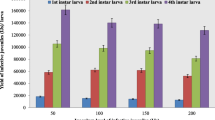Abstract
In rubber plantations, tree holes are one of the major types of breeding habitats of Aedes mosquitoes which transmit dengue and chikungunya. A mermithid nematode, Romanomermis iyengari, was evaluated in tree holes for its efficacy in controlling Aedes albopictus. Infection of mosquito larvae by the nematode was determined through microscopic examination on the next day of application, and evaluation of immature density of mosquito was done on the seventh day. After application of the infective stage of the nematode in a host–parasite ratio of 1:3 or 1:4, the infection rates on the different larval instars of mosquito were similar, 85.7–95.8 % in first to third instars and 79.3 % in fourth instar larvae or 100 and 92.9 %, respectively. Parasite burden varied from 1.1 to 2.4, respectively, among first and third instar larvae applied at 1:3. At 1:4, the parasite burden was between 1.6 (fourth instar) and 4 (second instar). The increase in parasite burden due to parasite density was significant in all the larval instars (P < 0.05). High parasite burden is detrimental to parasite recycling as it can cause premature mortality of the host. Hence, the dosage of 1:3 could be considered as suitable for rubber tree hole habitats. In the nematode-applied tree holes, there was a significant level (P < 0.05) of reduction in the immature density of A. albopictus, especially late instars and pupae, confirming the efficacy of R. iyengari in infecting the mosquito and controlling pupal emergence.





Similar content being viewed by others
References
Amer A, Mehlhorn H (2006) Larvicidal effects of various essential oils against Aedes, Anopheles, and Culex larvae (Diptera, Culicidae). Parasitol Res 99:466–472
Arjunan N, Murugan K, Madhiyazhagan P, Kovendan K, Prasannakumar K, Thangamani S, Barnard DR (2012) Mosquitocidal and water purification properties of Cynodon dactylon, Aloe vera, Hemidesmus indicus and Coleus amboinicus leaf extracts against the mosquito vectors. Parasitol Res 110:1435–1443
Chandrahas RK, Rajagopalan PK (1979) Mosquito breeding and the natural parasitism of larvae by a fungus Coelomomyces and a mermithid nematode Romanomermis in paddy fields in Pondicherry. Indian J Med Res 69:63–70
Gajanana A, Kazmi SJ, Bheema Rao US, Suguna SG, Chandrahas RK (1978) Studies on a nematode parasite (Romanomermis sp.: Mermithidae) of mosquito larvae in Pondicherry. Indian J Med Res 68:242–247
Keiser J, Maltese MF, Erlanger TE, Bos R, Tanner M, Singer BH, Utzinger J (2005) Effect of irrigated rice agriculture on Japanese encephalitis, including challenges and opportunities for integrated vector management. Acta Trop 95:40–57
Kumar NP, Suresh A, Vanamail P, Sabesan S, Krishnamoorthy K, Mathew J, Jose VT, Jambulingam P (2011) Chikungunya virus outbreak in Kerala, India, 2007: a seroprevalence study. Mem Inst Oswaldo Cruz 106:912–916
Maheswaran R, Ignacimuthu S (2012) A novel herbal formulation against dengue vector mosquitoes Aedes aegypti and Aedes albopictus. Parasitol Res 110:1801–1813
Muspratt J (1945) Observations on the larvae of tree-hole breeding Culicini (Diptera: Culicidae) and two of their parasites. J Entomol Soc South Africa 8:13–20
Paily KP, Balaraman K (1990) Effect of temperature and host–parasite ratio on sex differentiation of Romanomermis iyengari (Welch), a mermithid parasite of mosquitoes. Indian J Exp Biol 28:470–474
Paily KP, Balaraman K (2000) Susceptibility of ten species of mosquito larvae to the parasitic nematode Romanomermis iyengari and its development. Med Vet Entomol 14:426–429
Paily KP, Arunachalam N, Somachary N, Balaraman K (1991) Infectivity of a mermithid nematode Romanomermis iyengari (Welch) in different conductivity levels under laboratory and field conditions. Indian J Exp Biol 29:579–581
Paily KP, Arunachalam N, Reddy CMR, Balaraman K (1994) Effect of field application of Romanomermis iyengari (Nematoda: Mermithidae) on the larvae of Culex tritaeniorhynchus and Anopheles subpictus breeding in grassland. Trop Biomed 11:23–29
Pérez PR, Rodríguez HC, Lara RZ, Montes BR, Ruiz JV (2005) Control of the mosquito Anopheles pseudopunctipennis (Diptera: Culicidae) with Romanomermis iyengari (Nematoda: Mermithidae) in Oaxaca, Mexico. Biol Control 32:137–142
Petersen JJ, Willis OR (1972) Procedure for the mass rearing of mermithid parasite of mosquitoes. Mosq News 32:226–230
Petersen JJ, Chapman HC, Willis OR, Fukuda T (1978) Release of Romanomermis culicivorax for the control of Anopheles albimanus in El Salvador. II. Application of the nematode. Am J Trop Med Hyg 27:1268–1273
Platzer EG (2007) Mermithid nematodes. Am Mosq Control Assoc Bull 7:58–64
Rojas W, Northup J, Gallo O, Montoya AE, Montoya F, Restrepo M, Nimnich G, Arango M, Echavarria M (1987) Reduction of malaria prevalence after introduction of Romanomermis culicivorax (Mermithidae: Nematoda) in larval Anopheles habitats in Colombia. Bull Wld Hlth Org 65:331–337
Santamarina MA, Bellini AC (2000) Mass produced Romanomermis iyengari (Nematoda: Mermithidae) applied to anopheline breeding sites in Boa Vista (Roraima), Brazil. Pan Am J Pub Health 7:155–161
Santamarina MA, Perez PR (1997) Reduction of mosquito larval densities in natural sites after introduction of Romanomermis culicivorax (Nematoda: Mermithidae) in Cuba. J Med Entomol 34:1–4
Santamarina MA, Perez PR, Tomas-Martinez SH, Enrique CL, Flores AG (1999) The Romanomermis iyengari parasite for Anopheles pseudopunctipennis suppression in natural habitats in Oaxaca State, Mexico. Pan Am J Pub Health 5:23–28
Service MW (1976) Mosquito ecology—field sampling methods. Elsevier Applied Science Publishers, London
Theroux FR, Eldrige EF, Mallmann WL (1943) Laboratory manual for chemical and bacterial analysis of water and sewage. McGraw-Hill Book Company, London
Westerdahl BB, Washino RK, Platzer EG (1982) Successful establishment and subsequent recycling of Romanomermis culicivorax (Mermithidae: Nematoda) in a California rice field following post-parasite application. J Med Entomol 19:34–41
Acknowledgments
The authors are grateful to the staff of VCRC Field Station, Kottayam, Kerala, India for their help in the field work. They are also thankful to Mr. A. Ramamoorthy and Mr. S. Rajkumar, VCRC, Pondicherry, India for their assistance in the mass production and evaluation of the nematode.
Author information
Authors and Affiliations
Corresponding author
Rights and permissions
About this article
Cite this article
Paily, K.P., Chandhiran, K., Vanamail, P. et al. Efficacy of a mermithid nematode Romanomermis iyengari (Welch) (Nematoda: Mermithidae) in controlling tree hole-breeding mosquito Aedes albopictus (Skuse) (Diptera: Culicidae) in a rubber plantation area of Kerala, India. Parasitol Res 112, 1299–1304 (2013). https://doi.org/10.1007/s00436-012-3265-3
Received:
Accepted:
Published:
Issue Date:
DOI: https://doi.org/10.1007/s00436-012-3265-3




